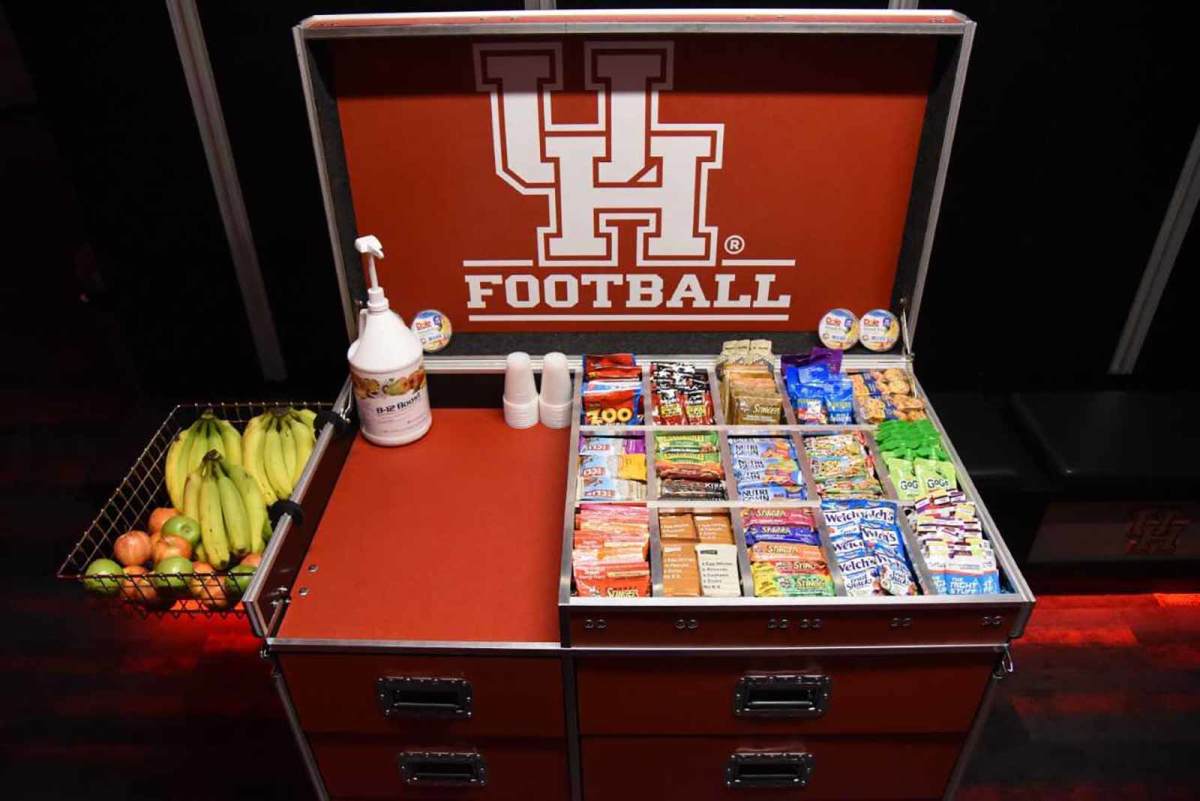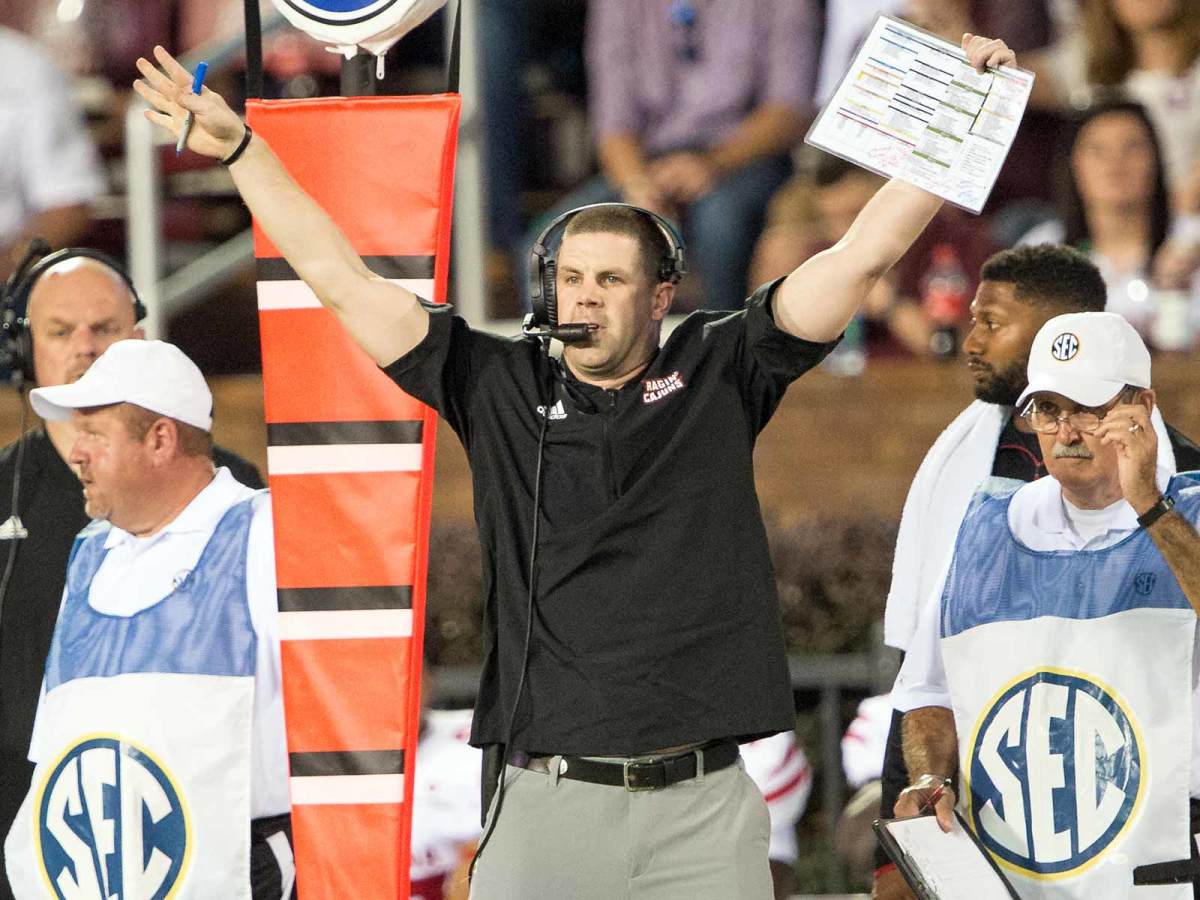The Legend and the Myth of the Halftime Adjustment

Penn State needed a spark. Midway through the 2016 Big Ten championship game, the Nittany Lions trailed Wisconsin 28–14. They had lost two first-half fumbles, were stuffed on a pair of fourth-down attempts and had gained three yards rushing. Not only that, but the Badgers were using a secondary alignment, Cover 3, that then offensive coordinator Joe Moorhead and his staff did not expect. Passing plays attacking such a coverage weren’t even on Moorhead’s play call sheet that week. That all changed during halftime.
“The offensive staff was sitting around,” recalls Moorhead, now the head coach at Mississippi State. “We discussed a play we had in practice that wasn’t on the call sheet. We had something that’s in our [computer] library that has the whole list of plays that we run in our system.” They scanned the list before a staff member found a double post play, something that attacks Cover 3. “‘Hey, why wouldn’t this be a good one?’” Moorhead remembers him saying. “Guys are like, ‘Let’s do it!’” On Penn State’s very first offensive snap of the second half, quarterback Trace McSorley found receiver Saeed Blacknall for a 70-yard touchdown pass on that double post, the spark the Nittany Lions needed for a comeback victory. “That,” Moorhead chuckles two years later, “was a pretty neat halftime adjustment.”
Halftime tweaks also happen on a much smaller scale in less significant games, like the one Tulane made last season to pull off a third-quarter fake punt after Green Wave coaches had recognized a vulnerability in East Carolina’s punt coverage team. The most revered head coaches in the game’s history don’t shy away from a midgame pivot, like the time Joe Paterno, steaming as his heavily favored Nittany Lions trailed Indiana, cut the second-half game plan to three rushing plays and three passing plays, telling assistants, “Enough of the gimmicky stuff!” Those decisions can swing the biggest of games, too, like Jimbo Fisher’s offensive formational switch that produced a second-half rally against Auburn to deliver Florida State the 2013 national championship.
But there is one halftime adjustment that trumps them all, a single move whose ripple effect is still being felt across college football. “It’s the biggest one in history,” says Louisiana head coach Billy Napier, “him changing quarterbacks.” By now, you know the story, a thing of legends at less than a year old: With his team trailing Georgia 13–0 in the national championship game, Nick Saban replaced his seasoned sophomore starting quarterback with an unproven true freshman, a move that sparked the Crimson Tide to a historic second-half rally and an overtime win.
Alabama and its two quarterbacks, junior Jalen Hurts and sophomore Tua Tagovailoa, are back in the College Football Playoff, and so too is its coach, who will leave no string unpulled in his latest pursuit of coaching glory. With two more victories, Saban will have a seventh national championship, more than any head coach in college football history. His halftime move in January of 2018 could go down as the signature decision of what very well could be the most successful career in the sport’s history. It’s clear no halftime could have been more impactful to such a meaningful game, but it invites the question: What really happens when the players head into the locker room?
The longstanding perception of halftime as the stage for legendary speeches and pivotal moments is one of sports’ great misconceptions, those in the industry contend. Those game-changing schematic adjustments you hear so much about—the same ones mentioned above—are overrated, one coach says, and those fire-and-brimstone speeches responsible for second-half comebacks are mostly exaggerated. Halftime doesn’t always fit the image in our heads: a passionate time rife with intense, motivational sermons and shrewd strategic changes. “Sometimes halftimes are,” former LSU quarterback Matt Mauck says with a pause, “boring.”
Halftimes are structured virtually the same at every level of college football. Usually in a secluded area, offensive and defensive coaching staffs hold separate meetings of about five minutes while players A) use the restroom, B) eat, C) receive medical attention or D) do all of the above at the same time. The bathroom is maybe the most active place in any halftime locker room, where at any point a player can be spotted using the facilities and eating a peanut butter and jelly sandwich while a trainer handles an IV bag attached to that player’s arm. The bathroom is a hectic place, often busy until the very end. “Everybody is rushing to go. Sometimes, there’s a line,” ex-New England Patriot and LSU quarterback Rohan Davey says. “I’ve seen some guys come out late for kickoff because they had to doodoo.”
The long-winded speeches and wholesale X's-and-O's changes you see transpiring during halftime in football movies rarely happen, mainly because of the short time window allowed: 20 minutes. That still seems like an eternity compared with the 12 minutes NFL coaching staffs get, says South Carolina coach Will Muschamp, who experienced pro halftime during his one year with the Miami Dolphins. “It’s like drinking water out of a firehouse,” Muschamp says. “You didn’t even have a chance to get the whole defense together.” Shortening college football halftime is discussed off-and-on by the sport’s leaders. Many coaches are against it, especially guys like Duke’s David Cutcliffe, 64. “I know there’s a lot of talk of it going to 15 minutes instead of 20,” he says. “I don’t think I’m that fast enough to run up the ramp in time. I’ve got trouble now.”
Many teams take a meandering route from the field to their locker rooms, up steep ramps, down dark tunnels or through grassy courtyards. Schools like Ole Miss have figured a way around it, holding halftime in a smaller room closer to the field at Vaught-Hemingway Stadium. Teams get, at most, about 14 minutes in the locker room together. Time is precious. That’s why Josh Thompson’s job at Louisiana is so important. Thompson, a 30-year-old Texas A&M graduate, loudly updates the locker room, sometimes aggressively, at every new halftime interval: five minutes for the coaches’ meetings, a few more minutes for positional meetings, another couple minutes for separate defensive and offensive gatherings and then, “Everybody up!” With a speech ranging from 30 to 90 seconds, the head coach sends his players out of the locker room and onto the field. Just like that, halftime’s over.
“It’s quick,” says David Pollack, the former Georgia defensive end who’s now an analyst on ESPN’s College GameDay. The speeches, though all relatively short, vary by coach. “I had [Mark] Richt so you’re asking the wrong guy about fiery speeches,” laughs Pollack. “Have you see Coach Richt talk? Then you know what his halftime is like.” Baylor ends its halftimes in an unusual manner under Matt Rhule. Hip-hop music comes pounding through the speakers as players filter out. Rhule is a Paterno disciple who played for the coach. “There was no music in the Penn State locker room,” Rhule laughs. “I can promise you that.”
Former USC and current Seahawks coach Pete Carroll is known for his spirited halftime energy, traditionally ending the event with four questions to his players. Can you win the game in the first quarter? No, they yell back. Can you win it in the second quarter? No, comes the response. Can you win the game in the third quarter? No, they shout again. Can you win the game in the fourth quarter? HELL YEAH, players cry, and they’re out the locker room in a mad dash.
Not everything about halftime is a bore. You know the stories about coaches punching walls, throwing chairs and breaking whiteboards? Although not a weekly occurrence, they are true. In fact, several major college equipment staffers, knowing the short lifespan of a whiteboard, have on reserve a massive trunk full of them. Strength coaches, always a rowdy, beefy bunch, are mostly responsible for the locker room destruction, but that wasn’t the case in the early 2000s. A young defensive coordinator at LSU left his mark on Alabama’s now-renovated visiting locker room. The hole he left on a bulletin board was so legendary that when team officials returned each year they scribbled next to it, “Will Muschamp was here.” Those days are over, Muschamp claims. “I’ve tried to move on from that,” he says. “My hands aren’t as strong as they used to be.”
Halftime on the road can be tricky. Visitors locker rooms, even those in the well-to-do SEC, don’t offer the plush amenities of the home team’s. Some are so small that two linemen can’t walk side by side, so forget about gathering 40 defensive players in a circle for a halftime powwow. Meetings are sometimes held outside in stadium tunnels or concourses, exposed to rabid opposing fans who, at one specific school, were known for hurling ice cubes at players and coaches (ahem, Tennessee).
The bathroom isn’t only a popular place for players. In the most cramped road locker rooms, coaches hold halftime meetings in the showers. “They’ll put some chairs on the ground in a circle, cold drinks, marker boards and bags of chips,” says longtime LSU strength coach Tommy Moffitt, who had stints at Tennessee and Miami. Tulane coach Willie Fritz is a 58-year-old journeyman in the profession, having spent time at every level of football—high school, junior college, Division II, FCS and now FBS. “I’ve been in some bad road locker rooms,” he says. He has operated from one junior college visiting locker room without bathrooms. Players were forced, in their gear and all, to do their business in the stadium alongside fans.
Food is an integral part of halftime. During any major college football locker room, roughly 100 people consume in a matter of 15 minutes about 15 gallons of water and sports drink, 40 pounds each of bananas and oranges, 16 giant bags of grapes and, over a course of an entire season at one school, more than 1,000 individual Rice Krispies Treats. “Rice Krispies are the favorites,” says Melinda Valliant, a nutritional specialist at Ole Miss. The energy players expend in the first half must be replaced with easily digestible carbohydrates and, to reduce cramping, electrolyte-injected drinks. Players can burn as much as 3–4,000 calories in a single game, and once a person loses 2% of his body weight, his performance starts to deteriorate, says Dwight Allison, an athletic nutritionist at Houston.

Universities are pouring funds into nutrition programs like never before. Allison recently purchased a $3,000 travel case specifically for transporting halftime road snacks. “It’s a buffet when you walk into a halftime,” says Pollack. “There’s always food: protein bars, the gels you squirt in your mouth, IVs … dude, IVs are the greatest. You get immediate hydration.” The buffet of goods can be distracting to laser-focused coaches. “You’ve got those damn support staff guys and they’ll eat everything,” Muschamp says. “They eat all the peanut butter and jelly sandwiches and everything. We had an administrator at Texas ... we’re playing Texas Tech at Lubbock trying to go win a national championship and I’ve got an administrative guy eating a peanut butter sandwich right next to me.” Food consumption has changed over the years. Under Paterno, for instance, a halftime meal normally consisted of a coffee cup of steaming hot chicken broth, designed to combat cold conditions. “I brought that to Baylor,” Rhule says, “when we played at Ohio State.”
What else happens during halftimes? Some players lie flat on their stomach, a trainer rolling a device across their back legs to ease an old injury. In cold weather situations, they warm their hands in heating devices, and during those September games in the south, they cool themselves with quick ice showers and chilled fans. Superstitious players change equipment; a bad first half can result in new cleats for a running back or a new mouthpiece for a defensive lineman. The most common change, equipment managers say, is new gloves for receivers. Greg Stringfellow, LSU’s longtime equipment director, has heard this plenty: “I’ve dropped two balls. I gotta change gloves!”

For coaches, halftimes are almost strictly about the X’s and O’s. Louisiana, a Sun Belt program in Lafayette, allowed Sports Illustrated into a halftime in November. A peek into the coaches’ meeting reveals a calm Napier speaking to his entire staff before focusing on his baby, the offense. He smoothly announces play calls for an assistant to add to or highlight on his play call sheet, intended to counter tactics from the opposing defense he’s noticed in the first half. The assistant is seated next to Napier, listening intently and furiously pecking on a computer. “We like to go through what we think works and doesn’t work,” says 25-year-old graduate assistant Matt Bergeron, the man behind the computer. “He rattles them off pretty fast. I’m just worried about getting them all down and getting them right.” Bergeron then prints the second-half plays onto a shipping label to stick onto Napier’s call sheet. “It’s a chess match,” Napier says. “That’s what’s fun about it.”
Napier’s halftime is set up identically to Alabama’s. He spent four years with the Crimson Tide as receivers coach. “Can’t help but do it that way,” he says. “It’s just a part of so much success doing it that way.” Coaches will tell you that Saban has spawned one of the better halftime adjusters in the game, Fisher, and one of the most passionate halftime motivators in the game, Muschamp. Back when the two men were Saban’s coordinators at LSU—Fisher the OC, Muschamp the DC—they were involved in “speech battles,” says Mauck, both coaches attempting to out-do the other in motivational tactics. Who won? “Jimbo is good,” Mauck says, “but Will is breaking dry-erase boards.”
Fisher’s halftime schematic changes played out on the biggest stage during the 2013 national championship game against Auburn. Down 21–10 at halftime, Fisher changed formations, not plays, to combat the blitzing Auburn used in the first half. “We said, ‘Maybe going three wide and two back and not bunching them up with a tight end,” Fisher recalls. The Seminoles won the second half 24–10. Years earlier, Fisher was involved in Saban’s first big halftime decision. The Jalen-to-Tua move wasn’t the first time the coach made a halftime quarterback change in a postseason game. LSU trailed Georgia Tech 14–3 at halftime of the 2000 Peach Bowl before Saban replaced starter Josh Booty for Davey. He threw for three second-half scores, and the Tigers came roaring back to win 28–14. Davey remembers a somewhat contentious halftime locker room when a group of seniors, led by cornerback Fred Booker, aggressively encouraged Saban and Fisher to change quarterbacks. “It was like a coup, I guess,” Davey says. “They made it clear that they wanted me to play the second half. They made it clear they wanted me in the game and if I wasn’t going to play, it was going to be a problem. I walked into the locker room, Coach Saban pulled me to the side and Jimbo let me know I was going to start the second half. We went out and beat the hell out of them.”
Davey watched last year’s national championship game on television. Fisher, meanwhile, was at the stadium as part of the broadcasting team. Neither was surprised to see Saban make another game-changing quarterback switch at halftime. “I knew he would do that,” Fisher says. This year, who knows, Saban might have an opportunity for another such move. Tagovailoa is coming off a badly sprained ankle in the SEC championship game, and Hurts is a few weeks removed from his late-game heroics in relief against Georgia. Is another halftime decision in the works? In a bustling locker room, Saban and his staff may produce another legendary moment to enhance the myth of halftime’s transformative power.
“We’ve won big games before, had big comebacks,” says Moffitt, Saban’s strength coach at LSU for five years, “and I’ve had friends on Sunday at church say, ‘Boy, coach must have cussed them out at halftime with some fiery speech!’ I’m thinking, ‘No, he didn’t.’ It’s not Knute Rockne standing on a chair. It’s just not like that.”
